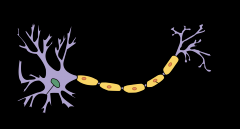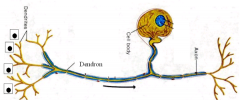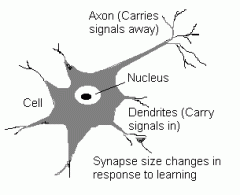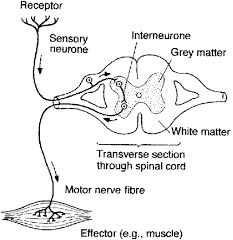![]()
![]()
![]()
Use LEFT and RIGHT arrow keys to navigate between flashcards;
Use UP and DOWN arrow keys to flip the card;
H to show hint;
A reads text to speech;
44 Cards in this Set
- Front
- Back
|
What is the Central Nervous System? |
The brain and spinal cord |
|
|
What is the Peripheral Nervous System? |
All of the nervous system except the brain and spinal cord, made up of nerves |
|
|
What is a nerve? |
A group of axons and dendrons, surrounded by a protective covering |
|
|
Define a) Dendrite b) Axon c) Dendron |
a) Short cytoplasmic processes that transmit action potentials from other neurones to a motor neurone b) A long cytoplasmic process that transmits an action potential away from the cell body of a neurone c) A long cytoplasmic process that transmits an action potential towards the cell body of a neurone |
|
|
Outline the direction of an action potential along a) Motor Neurone b) Sensory Neurone c) Relay Neurone |
a) From the CNS to an effector b) From a receptor to the CNS c) Between neurones
|
|
|
Draw a Motor Neurone |

|
|
|
Draw a Sensory Neurone |

|
|
|
Draw a Relay Neurone |

|
|
|
What is the myelin sheath? |
An insulating layer on an axon/dendron produced by a Schwann cell wrapping around it, enclosing it in layers of cell membrane |
|
|
What are Nodes of Ranvier? |
Gaps in the myelin sheath. |
|
|
What is a reflex arc? |
The pathway that an action potential travels from receptor to effector without concious thought. |
|
|
Outline the flow chart (roughly) at a reflex arc. |
1) Receptor 2) Sensory Neurone 3) Dorsal root ganglion 4) Sensory Neurone 5) Motor Neurone 6) Effector 7) Reflex Action |
|
|
Draw a spinal reflex arc |

|
|
|
What is the structure of a nerve? |
Axons are mostly found in bundles, surrounded by a protective layer called the perineurium. They can be myelinated or non-myelinated. |
|
|
How do neurones transfer information? |
Via electrial impulses - brief changes in the distribution of electric charge across a membrane. |
|
|
Outline the events that occur at resting potential |
At resting potential, the axon actively transports sodium and potassium ions in and out. (3Na out, 2K in). The membrane is more permeable for Potassium ions than Sodium, so there is a more positive charge outside the axon: the inside has a charge of -70mV. Some ions diffuse passively through other parts of the membrane also.
|
|
|
Outline the events that occur as an action potential is produced |
Voltage-gated channels also allow Sodium and Potassium ions to pass through the axon. They open and close depending on the potential difference. At resting potential they are closed, but can open in response to a stimulus such as touch. 1) Sodium ion channels open 2) Sodium ions that were actively transported out of the axon at resting potential flood back in due to the electrochemical gradient (to get rid of the positive charge and high concentration of Sodium ions outside) 3) There is no longer a positive charge outside of the axon - it is depolarised 4) There is an overshoot- too many Sodium ions enter the axon, causing the inside to be more positively charged than the outside. 5) This causes the potassium ion channels to open so Potassium ions flood out of the axon, so there is no longer a positive charge inside this is repolarisation 6) Again, there is an overshoot - too many Potassium ions leave the axon, so the outside becomes even more positive then resting potential. 7) All ion channels close and the distribution of ions and resting potential is |
|
|
How is an action potential transmitted? |
An action potential in one part of the membrane triggers the production of an action potential in the membrane next to it. When an action potential arrives, the membrane becomes temporarily depolarised and so creates a local circuit between the depolarised region and the resting regions either side. This triggers the depolarisation of adjoining regions, causing an action potential to sweep across the axon. |
|
|
Why is an action potential unidirectional? |
The part of the membrane behind the action potential is unable to produce another action potential because it is still recovering from the one it just had: it is still restoring the balance of ions and so is incapable of generating a new action potential. THIS IS CALLED THE REFRACTORY PERIOD. |
|
|
What is the 'All or Nothing' law? |
All action potentials are the same size. They are either generated or not generated. |
|
|
What affects the rate of conduction? |
* Diameter of the axon * Width of the axon (wider = faster) * Myelinated/Non-myelinated |
|
|
Describe the effect of myelination |
The myelin sheath is impermeable to sodium and potassium ions because there is a lack of voltage-gated channels. It 'insulates' the axon. This means the ions can only diffuse in and out at the Nodes of Ranvier every 1-3mm. This stretches the local circuits, causing an action potential to 'jump' from node to node, which is faster. THIS IS SALTATORY CONDUCTION |
|
|
What is a synapse? |
An area where a nerve impulse can be passed from one neurone to another or to an effector. |
|
|
What is the synaptic cleft? |
A gap between the synapses of neurones. |
|
|
What are cholingergic synapses? |
Synapses of which acetylcholine is the transmitter substance. |
|
|
Describe how an impulse is transmitted across a synapse |
1) The arrival of the action potential depolarises the pre-synaptic membrane 2) This causes voltage-gated calcium ion channels to open, and calcium ion channels flood in 3) This causes vesicles containing the transmitter substance to move to the pre-synaptic membrane 4) They fuse with the pre-synaptic membrane and release the transmitter substance into the synaptic cleft by exocytosis. 5) The transmitter substance diffuses across the cleft and binds to complementary receptors at the post-synaptic membrane. 6) This causes sodium ion channels in the post-synaptic membrane to open, triggering the production of an action potential. |
|
|
Why must transmitter substances be broken down? |
They may remain bound to the receptors in the post-synaptic membrane so * Sodium Ion channels may remain open * an action potential may constantly be generated * It may be impossible to reinstate resting potential, so no new action potentials can be generated. |
|
|
What is a neuromuscular junction? |
A synapse between a motor neurons and a muscle. The plasma membrane of the muscle fibre acts as the post-synaptic membrane, and it is caused to contract. |
|
|
How is acetylcholine broken down? |
The enzyme acetylcholinesterase splits it into two molecules - acetate and choline. Choline is then transported to the pre-synaptic membrane where it is combined with Acetyl CoA to reform Acetylcholine. This requires ATP which is provided by mitochondria. It is then transferred into vesicles ready for another action potential. |
|
|
Describe what happens to synapses when your brain receives information about two things at once |
New synapses form linking neurones involved in the passing of information along the pathway that follows from ears to eyes for example when you hear a voice and see a face at the same time. |
|
|
What is an inhibitory synapse? |
A synapse that reduces the likelihood of an action potential being generated after receiving an impulse. |
|
|
Why are synapses necessary? |
1) To ensure one way transmission Action potentials at synapses can only travel in one direction - this means signals are directed along a specific pathway and do not spread at random through the central nervous system. 2) Interconnecting nerve pathways At synapses many different neurones converge so that many pathways for the impulses are brought together. It may be necessary for an action potential to arrive along several different neurones simultaneously before an action potential can be generated in another. |
|
|
What is the effect of Nicotine at a synapse? |
Nicotine is a toxic chemical found in tobacco. It has a similar shape to acetylcholine and so can bind to the complementary receptors at the post-synaptic membrane of a synapse. However, nicotine is not as easily broken down. |
|
|
What is the effect of the Botulinum Toxin at a synapse? |
The Botulinum Toxin is produced by an anaerobic bacterium that can breed in contaminated canned food. It acts at the pre-synaptic membrane by preventing the release of acetylchloine. It can treat a disorder where the eyelid muscles permanently contract.
|
|
|
What are the effects of Organophorphorous Insecticides? |
They are found in many pet flea sprays. It inhibits acetylcholinsterase - and so results in the continuous production of an action potential in the post-synaptic membrane. |
|
|
Purple Book What are transducers? |
convert one form of energy to another |
|
|
Purple Book How are energy transducers adapted? |
They are adapted to detect changes in a particular form of energy - i.e. change in light levels, pressure on skin etc (stimulus) |
|
|
Purple Book What is a generator potential? |
A small depolarisation caused by sodium ions entering the cell. If there is a larger stimulus, and more gated channels open, it can initiate an action potential |
|
|
Purple Book How is a neruone adapted to its function? |
- Very long so they can transmit action potentials over a long distance - Plasma membrane has many gated ion channels that control the entry or exit of sodium, potassium or calcium ions - They have sodium/potassium ion pumps that use ATP to actively transport sodium ions out of the cell and potassium ions into the cell - They maintain a potential difference across the plasma membrane -Surrounded by mylien sheath that insulates. - Have a nucleus many mitochondria and ribosomes in the cell body |
|
|
Purple Book How is the interior of the cell maintained at a negative potential compared to the outside? |
Plasma membrane is more permeable to K ions than to Na so many diffuse out again and the cell cytoplasm contains large organic anions. |
|
|
Purple Book What is the threshold potential? |
A potential difference across the membrane of about -50mV. If the depolarisation of the membrane does not reach the threshold potential then no action potential is created. |
|
|
Purple Book What are the roles of synapses? |

|
|
|
Purple Book Typical speed of transmission in myelinated |
100-120 m s-1 |
|
|
Purple Book Typical speed of transmission of non-myelinated |
2-20 m s-1 |

